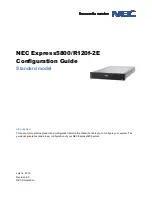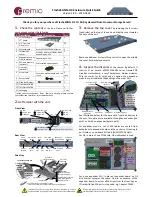
Document Number: 001-98285 Rev. *R
Page 14 of 108
S29GL01GS/S29GL512S
S29GL256S/S29GL128S
3.4
Sector Protection Methods
3.4.1
Write Protect Signal
If WP# = V
IL
, the lowest or highest address sector is protected from program or erase operations independent of any other ASP
configuration. Whether it is the lowest or highest sector depends on the device ordering option (model) selected. If WP# = V
IH
, the
lowest or highest address sector is not protected by the WP# signal but it may be protected by other aspects of ASP configuration.
WP# has an internal pull-up; when unconnected, WP# is at V
IH
.
3.4.2
ASP
Advanced Sector Protection (ASP) is a set of independent hardware and software methods used to disable or enable programming
or erase operations, individually, in any or all sectors. This section describes the various methods of protecting data stored in the
memory array. An overview of these methods is shown in
.
Figure 3.1
Advanced Sector Protection Overview
Every main flash array sector has a non-volatile (PPB) and a volatile (DYB) protection bit associated with it. When either bit is 0, the
sector is protected from program and erase operations.
The PPB bits are protected from program and erase when the PPB Lock bit is 0. There are two methods for managing the state of
the PPB Lock bit, Persistent Protection and Password Protection.
Password Method
(DQ2)
Persistent Method
(DQ1)
Lock Register
(One Time Programmable)
PPB Lock Bit
1,2,3
64-bit Password
(One Time Protect)
1 = PPBs Unlocked
0 = PPBs Locked
Memory Array
Sector 0
Sector 1
Sector 2
Sector N-2
Sector N-1
Sector N
4
PPB 0
PPB 1
PPB 2
PPB N-2
PPB N-1
PPB N
Persistent
Protection Bit
(PPB)
5,6
DYB 0
DYB 1
DYB 2
DYB N-2
DYB N-1
DYB N
Dynamic
Protection Bit
(DYB)
7,8,9
7. 0 = Sector Protected,
1 = Sector Unprotected.
8. Protect effective only if corresponding PPB
is “1” (unprotected).
9. Volatile Bits: defaults to user choice upon
power-up (see ordering options).
5. 0 = Sector Protected,
1 = Sector Unprotected.
6. PPBs programmed individually,
but cleared collectively
1. Bit is volatile, and defaults to “1” on reset (to
“0” if in Password Mode).
2. Programming to “0” locks all PPBs to their
current state.
3. Once programmed to “0”, requires hardware
reset to unlock or application of the
password.
4. N = Highest Address Sector.
















































